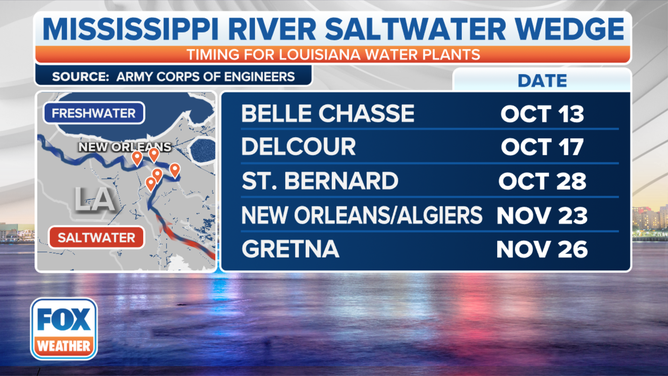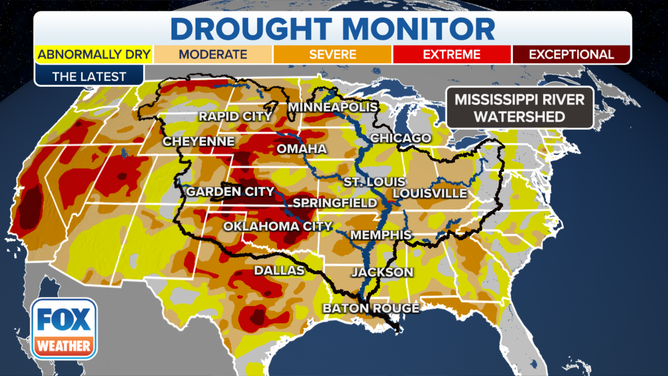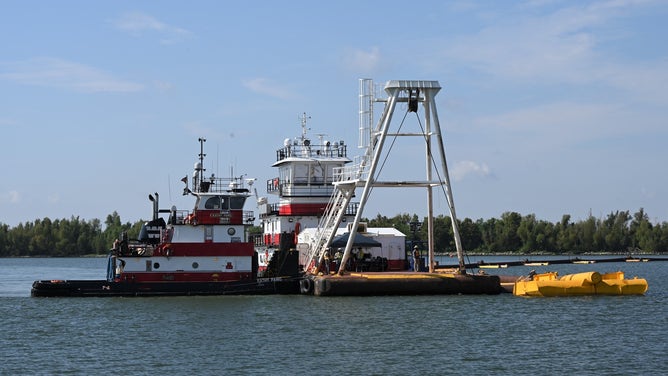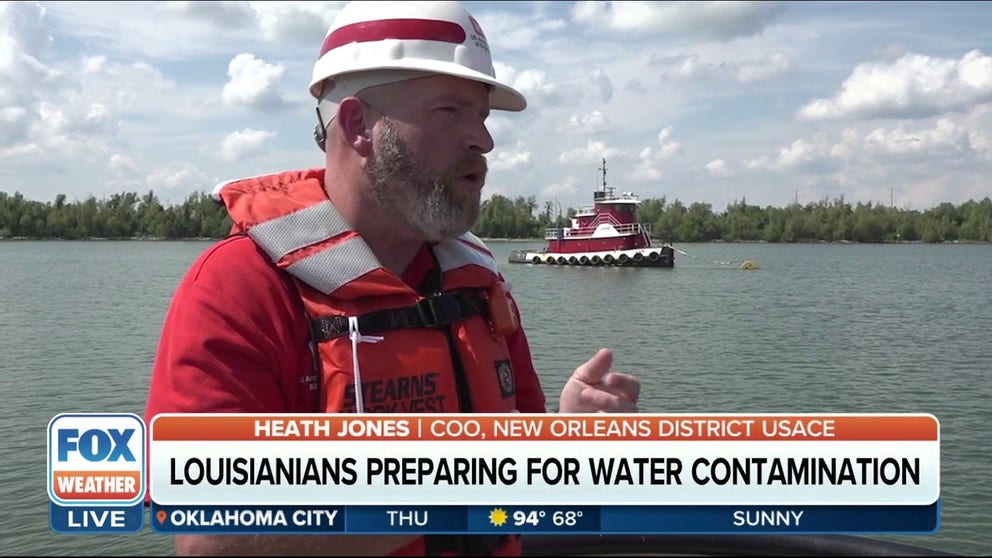Salt water not expected to reach New Orleans until late November with improved Mississippi River forecast
Based on the new timeline, the salt water will be at the Algiers Water Treatment Plant in late November, and it's possible the salt water may not reach the water treatment plant on the Eastbank of New Orleans.
New Orleans freshwater supply threatened by salt water creeping into Mississippi River
Drought has caused the flow of the Mississippi River to run low, compromising its ability to hold the salt water of the Gulf of Mexico at bay. Sept. 27, 2023.
NEW ORLEANS – Residents in Louisiana received good news on Thursday as officials say the forecast has improved on the lower Mississippi River, delaying the salt water from the Gulf of Mexico moving further upriver.
Drought and low water levels in the lower Mississippi River have allowed salt water from the Gulf of Mexico to win the battle and push farther up the river, impacting local water treatment centers.
The new saltwater wedge timeline from the U.S. Army Corps of Engineers New Orleans District released on Thursday shows efforts to augment a sill, or underwater levee, in the river, and the flow-level forecast has improved, delaying the seawater reaching additional water treatment facilities by about a month compared to the previous estimates.
Based on the new timeline, the salt water will be at the Algiers Water Treatment Plant in late November, and it's possible the salt water may not reach the Carrolton Water Treatment Plant on the Eastbank of New Orleans. The previous timeline put the salt water at the Algiers plant by the end of October.

Saltwater intrusion timeline as of Oct. 5.
(FOX Weather)
Two water plants serve the New Orleans area. The Carrolton Water Treatment Plant treats about 150 million gallons of water daily, and the Algiers Water Treatment Plant treats about 12.5 million gallons of water daily.
The U.S. Army Corps of Engineers New Orleans District began work more than a week ago to raise the sill by an additional 25 feet. The sill is designed to delay the salt water from the Gulf of Mexico from moving up the river, and engineers say it appears to be working already.
Col. Colin Jones, 65th Commander and district engineer for the USACE New Orleans District, said the saltwater wedge has remained stationary since Sept. 24 at river mile 69.4, the same day the construction of the augmented sill started about six miles away.
"Our daily river surveys show that the salt water that overtops the sill has less salinity and density than that behind the wedge. And what that means is it makes it very sensitive to upticks in flow in the river, which we've seen through the month of September," Jones said. "This benefit, coupled with the better forecasted flows in September and the updated 28-day National Weather Service forecast going into October has enabled us to update our models and projections for the saltwater impacts."

Drought in the Mississippi River Watershed stems from the Midwest.
(FOX Weather)
Jones said the sill is about 62% complete and expected to be finished by Oct. 12.
Improved flow forecast and sill helping to hold back salt water
This is the second year drought conditions in the river have threatened drinking water in southeast Louisiana. While more than 90% of Louisiana is under extreme to exceptional drought, the problem with the river stems from drought in the Midwest. Much of the river's flow comes from rainfall in the upper parts of the Midwest.
Normally, the Mississippi River holds off the Gulf of Mexico with a flow of about 300,000 cubic feet per second (CFS). The flow has been almost half that due to drought, according to the USACE.
Jones said the flow forecast from the National Weather Service has improved.
"Originally, we had flows going from 145,000 CFS dropping to 128,000 CFS across the 28-day forecast. Thankfully, we've stayed between around 145,000 CFS and 155,000 CFS, so better than predicted. That's given us additional time," Jones said.
The current forecast has the flow dropping to around 133,000 CFS over the next 28 days.
"Those better than forecasted flows helped delay the progress of the saltwater sill, but also working in conjunction with the benefits that we're seeing from augmenting the spill at (river mile) 63.8," Jones said.

The J. S. Chatry contracted by the USACE New Orleans District for a dredge to build up the current sill in the lower Mississippi River to hold off the saltwater intrusion. (Image: U.S. Army Corps of Engineers New Orleans District)
(USACE)
Despite the improved forecast, contingency plans to barge in fresh water and a possible pipeline to circumvent the salt water remain in place, officials said.
On Sunday, the U.S. Army Corps of Engineers began barging fresh water from an upstream location to water treatment facilities in Plaquemines Parish to dilute the salinity content to levels safe for water treatment.
The initial barge load of 500,000 gallons was delivered to the Port Sulphur Water Treatment Facility.
"As barges arrive at water treatment facilities, the fresh water will be transferred to storage or reservoir tanks and then mixed with salt water from the river to bring the chloride levels down below the threshold for treatment," the USACE said.
The USACE is working on the capability to deliver up to 36 million gallons of water per day if the saltwater intrusion impacts additional facilities on the Mississippi River.
An emergency declaration remains for four parishes threatened by the advancing salt water.
